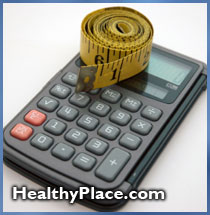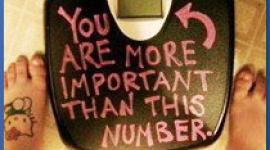Figuring Out Fat and Calories
You want to look and feel your best. But does this mean you should watch your weight, eat fat-free foods, and count calories? Start by getting the facts on fat and calories, then decide for yourself.
What Are Fat and Calories?
Fats, or lipids, are nutrients in food that your body uses to build nerve tissue (like the brain) and hormones. Your body also uses fat as fuel. If fats that you've eaten aren't burned as energy or used as building blocks, they are stored by the body in fat cells. This is your body's way of thinking ahead: by saving fat for future use, your body plans for times when food might be scarce.
A calorie is a unit of energy that measures how much energy food provides to your body. When some people hear the word calorie, they think calories are a bad thing. But the truth is that everybody needs to have calories. Your body needs calories to function properly.
How Are Calories and Fat Represented on Food Labels?
Food labels list calories by the amount in each serving size. Serving sizes differ from one food to the next, so to figure out how many calories you're eating, you'll need to do three things:
- Look at the serving size.
- See how many calories there are in one serving.
- Multiply the number of calories by the number of servings you're going to eat.
For example, a bag of cookies may list three cookies as a serving size. But if you eat six cookies, you are really eating two servings, not one. To figure out how many calories those two servings contain, you must double the calories in one serving.
When you start looking at food labels, you may be surprised at some of the serving sizes! Food companies want their foods to seem healthier, low in fat, or low in calories, so they may make their serving size smaller than the portion size most people would normally eat.
 For example, on the labels of six cold breakfast cereals, the serving size ranges from 1/2 cup to 1 3/4 cups. You would have to more than triple the smallest serving size (1/2 cup) to compare the calories in that cereal with the calories in the cereal with the largest serving size (1 3/4 cups). A bag of corn chips might list five chips as a serving size. But you'd have a hard time finding anyone who would eat only five chips! That's why it's always important to compare serving sizes.
For example, on the labels of six cold breakfast cereals, the serving size ranges from 1/2 cup to 1 3/4 cups. You would have to more than triple the smallest serving size (1/2 cup) to compare the calories in that cereal with the calories in the cereal with the largest serving size (1 3/4 cups). A bag of corn chips might list five chips as a serving size. But you'd have a hard time finding anyone who would eat only five chips! That's why it's always important to compare serving sizes.
When it comes to fat, labels can say many things. Low fat, reduced fat, light (or lite), and fat free are common terms you're sure to see splashed across food packages. The government has strict rules about the use of two of these phrases: By law, fat-free foods can contain no more than 0.5 grams of fat per serving. Low-fat foods may contain 3 grams of fat or less per serving. Foods marked reduced fat and light (lite) are a little trickier, and you may need to do some supermarket sleuthing.
Light (lite) and reduced-fat foods may still be high in fat. The requirement for a food to be labeled light (lite) is that it must contain 50% less fat or one third fewer calories per serving than the regular version of that food. Foods labeled reduced fat must contain 25% less fat per serving than the regular version. But if the regular version of a particular food was high in fat to begin with, a 25% to 50% reduction may not lower the fat content enough to make it a smart snacking choice. For example, the original version of a brand of peanut butter contains 17 grams of fat and the reduced fat version contains 12 grams. That's still a lot of fat!
And don't expect the label to tell it all. The percentage of fat in a food isn't always listed on the label. But it is easy to calculate. Divide the number of calories from fat by the number of total calories and multiply by 100.

For example, if a 300-calorie food has 60 calories from fat, you divide 60 by 300 and then multiply by 100. The result shows that food gets 20% of its calories from fat.

Knowing how to figure out how many calories you're getting from fat is important. U.S. Dietary Guidelines recommend that no more than 30% of all the calories you eat in a day should come from fat.
4, 4, and . . . 9?
Food calories come from carbohydrates, proteins, and fats. A gram of carbohydrate contains 4 calories. A gram of protein also contains 4 calories. A gram of fat contains 9 calories - more than twice the amount of the other two. That's why a food with the same serving size as another may have far more calories. A high-fat food has many more calories than one low in fat and higher in protein or carbohydrates.
For instance, a 1/2-cup serving of vanilla ice cream contains:
- 178 total calories
- 2 grams of protein (2 grams times 4 calories = 8 calories from protein)
- 12 grams of fat (12 grams times 9 calories = 108 calories, or 61%, from fat)
- 15.5 grams of carbohydrate (15.5 grams times 4 calories = 62 calories from carbohydrate)
Compare this to the same serving size (1/2 cup) of cooked carrots:
- 36 total calories
- 1 gram of protein (1 gram times 4 calories = 4 calories from protein)
- 0 grams of fat (0 grams times 0 calories = 0 calories from fat)
- 8 grams of carbohydrate (8 grams times 4 calories = 32 calories from carbohydrate)
These two examples show what a difference fat makes when it comes to total calories in a food.
But let's face it: who's going to choose a heaping bowl of cooked carrots over luscious ice cream on a hot summer day? It all comes down to making sensible food choices most of the time. According to Debby Demory-Luce, PhD, a dietitian, "The goal is to make trade-offs to balance a higher-fat food with foods that are lower in fat to keep the fat intake at 30% for the day." So if you really want that ice cream, it's OK once in a while - as long as you work in some lower-fat foods, like carrots, that day.
Are All Types of Fat the Same?
All types of fat have the same amount of calories, but not all fats are created equal - some are more harmful to your health than others. Two of the most harmful fats are saturated fat and trans fat. Both of these fats can increase a person's risk of heart disease - and experts believe that trans fat may carry an even greater health risk than saturated fat.
Saturated and trans fats are solid at room temperature - like butter, shortening, or the fat on meat. Saturated fat comes mostly from animal products, but some tropical oils, like palm kernel oil and coconut oil, also contain saturated fat. Trans fat is also found in whole dairy and meat products. But one of the most common sources of trans fat in today's foods is hydrogenated vegetable oil. Hydrogenated oils are liquid oils that have been changed into a solid form of fat by adding hydrogen. This process allows these fats to keep for a long time without losing their flavor or going bad. Trans fats are often found in packaged baked goods, like cookies, crackers or potato chips. They are also in fried foods like french fries and doughnuts. Because saturated fat and trans fat are tied to heart disease, a gram of one of these fats is worse for a person's health than a gram of unsaturated fat.
Unsaturated fats are liquid at room temperature. Unsaturated fats can be polyunsaturated or monounsaturated. Polyunsaturated fat is found in soybean, corn, sesame and sunflower oils, or fish and fish oil. Monounsaturated fat is found in olives, olive oil or canola oil, most nuts and their oils, and avocados.
Fat and Calories in a Healthy Diet The Food Guide Pyramid shows that fats should be used sparingly. The American Heart Association recommends people get as much of their daily fat intake as possible from unsaturated fats and that they limit saturated fats and trans fats - or at least keep their consumption of these fats to no more than 10% of their daily diet. Saturated fats are listed on food labels. Keeping track of trans fat is also going to be easier - the FDA requires that, by 2006, all food companies list the amount of trans fat in a product on its food label.
With all the talk about fat and tons of low-fat products out there, some teens may decide to completely cut out fat from their diet. Bad idea! Some fat is needed for good health. Fat is necessary for developing bodies, especially during puberty, when the body grows very quickly.
Fats are also needed to absorb certain vitamins that are essential for proper growth. Vitamins A, D, E, and K are known as fat soluble, meaning they can only be absorbed if there is fat in a person's diet. Also, fat cells act as insulation to keep your body warm and make up part of the outer coating that protects your nerve cells. When it comes to foods, a little fat is where it's at - you should never try to stop eating fat completely.
Likewise, you need a certain amount of calories in your diet to fuel your body. In fact, Dr. Demory-Luce doesn't recommend calorie counting (the term for keeping track of the number of calories in everything that you eat) unless a person's doctor has specifically ordered it. "Even for teens who are overweight," she says, "making wise food choices and increasing activity would be more healthy." If you are concerned about your weight, speak to your doctor.
Maintaining a healthy weight means choosing foods that are low in fat and high in complex carbohydrates. Think about which foods you can substitute for those in your diet that are high in sugar, fat, or calories - such as drinking water or skim milk instead of soft drinks or choosing mustard instead of mayonnaise on your sandwich. Other healthy food choices include:
- low-fat or fat-free dairy products
- fresh fruits and vegetables
- whole-grain cereals and breads
- lean meats
Being aware of the amount of fat and calories you eat makes sense, as long as you eat a balanced diet. Establishing sensible eating habits, choosing foods wisely and exercising regularly are the keys to long-term good health.
next: Food Anxiety: Food Shapes Our Identity and Influences How We See the World
~ eating disorders library
~ all articles on eating disorders
APA Reference
Gluck, S.
(2008, December 8). Figuring Out Fat and Calories, HealthyPlace. Retrieved
on 2025, December 14 from https://www.healthyplace.com/eating-disorders/articles/figuring-out-fat-and-calories



